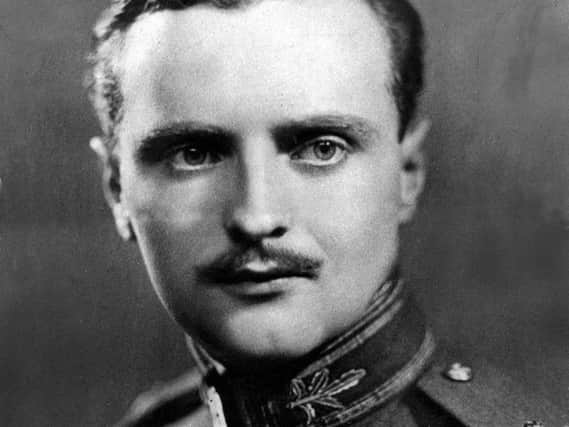Glasgow museum honours 'forgotten air ace' who shot first German aircraft down over Britain during Second World War


A panel from the plane shot down by Paisley-born Archie McKellar in October 1939 has pride of place in the new displays honouring the squadron leader.
McKellar, a member of the 602 (City of Glasgow) Squadron, was responsible for shooting down 21 German aircraft during the first few months of the conflict.
Advertisement
Hide AdHowever his name was controversially left off the Royal Air Force's official Battle of Britain roll of honour as he was thought to have died eight hours after it ended.
Now Kelvingrove Art Gallery and Museum in Glasgow has decided to pay tribute to McKellar as part of a showcase of exhibits draw from his squadron's collections.
Also on show in the museum's "Conflict and Consequences" gallery are letters he wrote and received, photographs and a portrait, together with a uniform representing the one he would have worn to protect him from the freezing temperatures experienced at higher altitudes.
McKellar, who was born in 1912, grew up fascinated by stories of First World War pilots, and joined the Scottish Flying Club, which was based at Renfrew Airport, when he was 21.
This brought him to the attention of Douglas Douglas-Hamilton, Lord Clydesdale, who commanded the 602 (City of Glasgow) Squadron, which was based at nearby RAF Abbotsinch.
Following the outbreak of the war in September 1939, the Spitfires of 602 Squadron were posted to RAF Drem in East Lothian.
Advertisement
Hide AdOn 28 October he shot down a Heinkel HE-111 Bomber over Humbie - the first German aircraft shot down on to British soil in the war.
He went on to become a hugely successful and decorated pilot
Advertisement
Hide AdArchie was just 28 when he was killed shortly after 8am on November 1, 1940, when his Hurricane plane crashed after being hit by enemy fire above Kent. Government officials later ruled the Battle of Britain had lasted until midnight on October 31, 1940.
John Messner, curator with Glasgow Museums, who worked with 602 (City of Glasgow) Squadron to create the display said: "Archie’s story is a fantastic addition to the displays already to be found in the Conflict and Consequences Gallery, which give insight into the human impact of war.
"The objects bring his story to life and it is thanks for the 602 (City of Glasgow) Squadron Museum that these have been saved for posterity.
Roddy MacGregor, honorary secretary of the 602 Squadon Museum Association, said: ‘We’ve relished the opportunity to work with the team at Glasgow Museums to create this new display on the 602 (City of Glasgow) Squadron’s actions at the start of World War II.
"We very much hope it will add to the important conversation about the human side of conflict today."
David McDonald, chair of Glasgow Life, which runs Kelvingrove, said: ‘More than one million people visit Kelvingrove every year and they return time and again because we work hard to refresh the stories we share in our galleries.
Advertisement
Hide Ad"Our 'Conflict and Consequences' gallery explores themes that are sadly all too real for many across the world today, therefore it is important we continue to raise awareness of the enduring human cost of conflict. This idea is imbued in Archie McKellar’s story.
"It is evident to all he was an incredibly brave man and we are all grateful to him for making the ultimate sacrifice.
"We are also grateful to the 602 (City of Glasgow) Squadron Museum Association for helping to create this new display."